Using European (Mainland) Equipment in the UK (Safely)
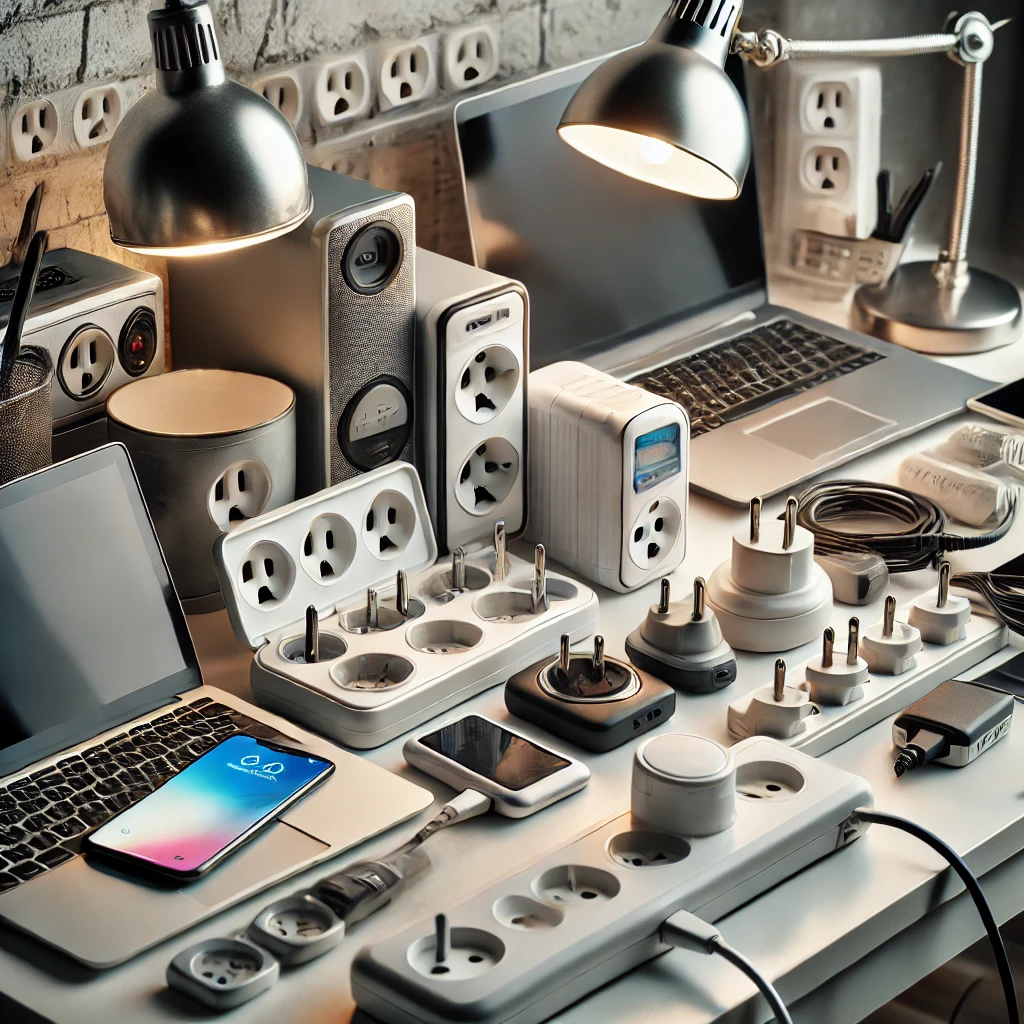
| Disclaimer: I do not accept any responsibility and any hints and tips are used at your own discretion. If in any doubt whatsoever, seek the advice of a qualified electrical technician.
Messing with electrics can be dangerous. |
With that out of the way, there are several ways how European equipment can be used in the UK. To start with I will give a bit of background.
Background
Other than the obvious difference in the shape of the plug, the system in the UK is different to most European. The Electrical mains system is designed with Electrical heating in mind. This is why ring mains are fused with 32 amp at the fusebox or Consumer Unit. This is twice as much compared to Germany or the Netherlands where the mains is fused at 16A.
The second difference is the UK plugs are fused so faulty equipment is not exposed to the full 32A, which can cause a fire.
In addition, attention needs to paid to how both systems work from a safety and earthing perspective. Both UK and European systems work the same:
- Double insulated; this means that whatever happens, the housing can never be exposed to the mains voltage. In many cases, the housing is made of plastic and are usually small apparatus.
- With Protected Earth (Rand Aarde or Schutz Kontakt (or Schuko)). These are often apparatus that are used in kitchens etc., and generally consume more power or may be operated in humid environments.
Then there is also a difference with how energy is distributed. In the UK single-phase is used at very high currents, where as most European networks distribute three phases allowing for a more efficient operation. This is more complex to understand but one thing to remember, a Dutch Cooker will not work in the UK without modification (3phase to single phase conversion) and a UK electrical shower will never work in the Netherlands or Germany (as they can consume up to 40A and the highest current in residential areas is 16A).
A bit about fuses
Safety is as good as the weakest link. One often sees a 13 amp (brown fuse) for a 20 Watt desk lamp etc. The correct fuse should be used for its application otherwise your equipment may stop due to a blown fuse or the equipment may be blown before the fuse does. The table is a bit of a guidance and it should be noted that 5A fuses may no longer be fitted in new equipment.
| Clock radio – 3 amp. | Lamp – 3 amp. |
| Coffee maker – 5 amp. | Laptop PC – 3 amp. |
| Dishwasher – 13 amp. | Microwave oven – 5 amp. |
| DVD player – 3 amp. | PC – 3 amp. |
| Electric blanket – 3 amp. | Radio – 3 amp. |
| Fan – 3 amp. | Table lamp – 3 amp. |
| Food mixer – 3 amp. | Toaster – 5 amp. |
| Fridge – 3 amp. | TV – 3 amp. |
| Hair dryer – 13 amp. | Vacuum cleaner – 3 amp. |
| Hi-fi – 5 amp. | Video player – 3 amp. |
| Iron – 13 amp. | Washing machine – 5 amp. |
| Kettle – 13 amp. |
The flexible way
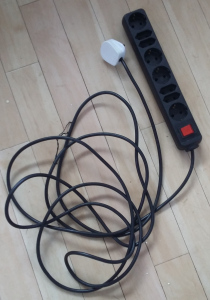 The flexible way is to put a UK plug on a European trailing socket
The flexible way is to put a UK plug on a European trailing socket
The obvious way (if you are Handy)
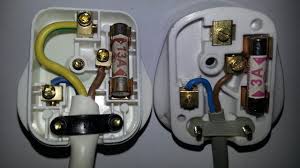 The obvious way is to cut off the European plug and install a UK BS plug. The problem is, not everybody is capable or confident enough. In many cases, it also voids any warranty or if you want to use it in Europe again, you have the same problem but then in reverse…
The obvious way is to cut off the European plug and install a UK BS plug. The problem is, not everybody is capable or confident enough. In many cases, it also voids any warranty or if you want to use it in Europe again, you have the same problem but then in reverse…
If however, you want to do this, here is the way the wires should go. Note the plug on the right is missing the yellow/green wire. This is the case for equipment that is double insulated.
As an electrician in the Netherlands, I was taught to tin the wires first. In the same year, we were taught to stop doing that as the wires are more likely to break under the screw when soldered. Hence just twist the strands.
(Did you know that not long ago, in the UK you would purchase equipment without a plug fitted?)
The Dangerous way…
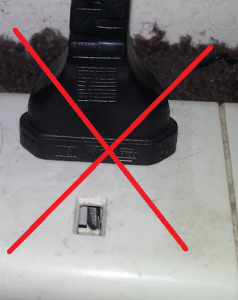 A quite common way was to push the safety shutter down with a screwdriver or car key and push the round pins in the square holes. THIS IS EXTREMELY DANGEROUS!! Newer sockets do not allow you to do this anymore. Pressure has to be from three pins at the same time.
A quite common way was to push the safety shutter down with a screwdriver or car key and push the round pins in the square holes. THIS IS EXTREMELY DANGEROUS!! Newer sockets do not allow you to do this anymore. Pressure has to be from three pins at the same time.
Issues are:
- When plugging it in, there is a chance of electrocution
- When unplugging, the caps of the plug may stay in the socket, exposing metal parts that are live and electrocution is likely
- The apparatus is not properly fused and exposed to 32A, which can cause a fire in case of malfunction
- If one uses this method with an Earthed plug, the Safety Earth is not connected. In case of a failure, the equipment housing may become live and electrocution is likely.
- Round pins in square holes. The contact surface is minimal, causing the plug and socket to overheat and thus the possibility of a fire!
The temporary way.
Due to international travel, converter plugs are widely available. As with everything, our Asian friends are flogging the market with inferior products. The main issue is that the converters are NOT fused and are of poor construction. Also when used with earthed equipment the earth is not connected.

Ok, you can pick them up for less than 70 p from websites but stay away from it. BTW,In China, they are not allowed to be used!
See the note “For Export use Only”
So now a couple of methods that are relatively safe.
| Type | Euro Plug | Plug with Earth | Use |
Shaver Adapter |
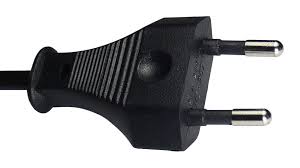 Not all plugs may fit Not all plugs may fit |
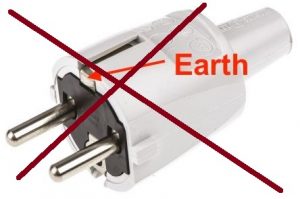 |
Electric Shaver, Electric Toothbrush, Phone Charger. Not suitable for hairdryers as the current is too high, the fuse will blow instantly. New converter types have holes that are very close and may not fit all plugs.
Should never be used with Earthed plugs! |
Visitor Adapter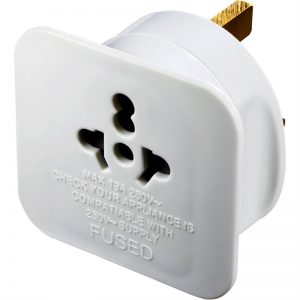 |
 |
 |
As above and any other equipment with a class two plug that does not exceed the rating of the fuse.
Should never be used with Earthed plugs! |
EU to BS Adapter with Protective Earth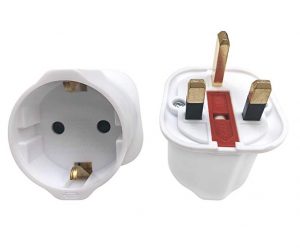 |
 |
 |
Any plug including earthed ones can be used with this adapter. A bit more expensive but much more sturdy and can be used up to 13A. |
The permanent way.
Due to mass production, more and more equipment has found its way on the UK market. For this reason, there are now permanent adapters that can be used by importers or manufacturers. These are now also available on the UK market and can be sourced from CEF, RS and sometimes Amazon and eBay. Always check that they are fused and have a BS mark.
There is one thing to remember. There are two versions of each, normal standard screw and NON-RETURNABLE screw. The latter means you can fit it but it is not removable…
| Type | Euro Plug | Plug with Earth | Use |
 |
 |
 |
Any equipment with a class two plug that does not exceed the rating of the fuse.
Earthed Plugs will not fit! |
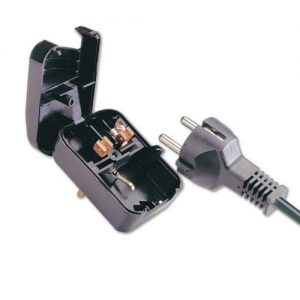 |
 |
 |
Any plug can be used with this adapter style and can be used up to 13A. From a sturdiness and esthetics point of view, I recommend to use the correct one for the type of plug. |
The inlet way.
Not all apparatus have a permanent lead and may have an inlet. In that case, you can just replace the lead. For example for my work laptop, I carry a European, British and US lead and never use these dodgy travel adapters that are too big to fit in any hotel or conference room power outlet.

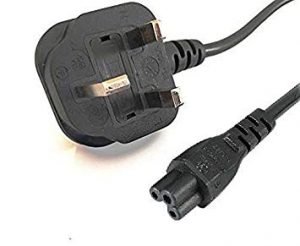
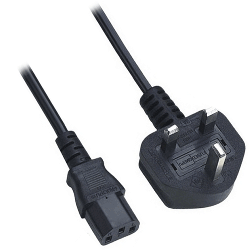

Although both C14 and C15 are both colloquially reverted to as kettle leads, the only real kettle lead is (also called a hot version) C15, C15 will fit C14 but not vice-versa. See the cutout at the bottom. so if you have a frier, hotplate, Electric Fondu etc, you most likely need a C15.